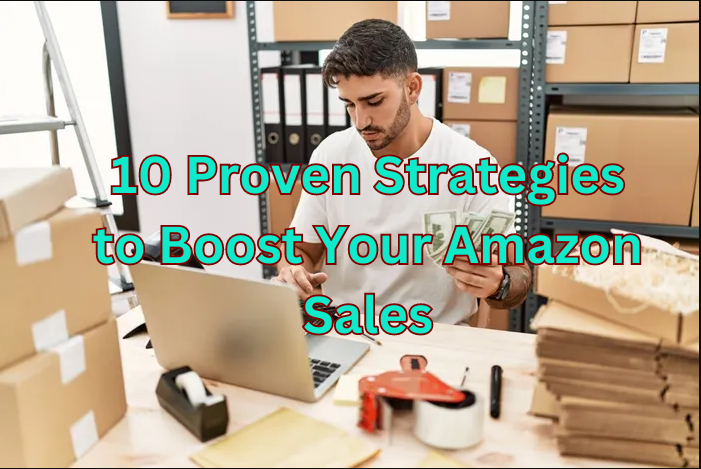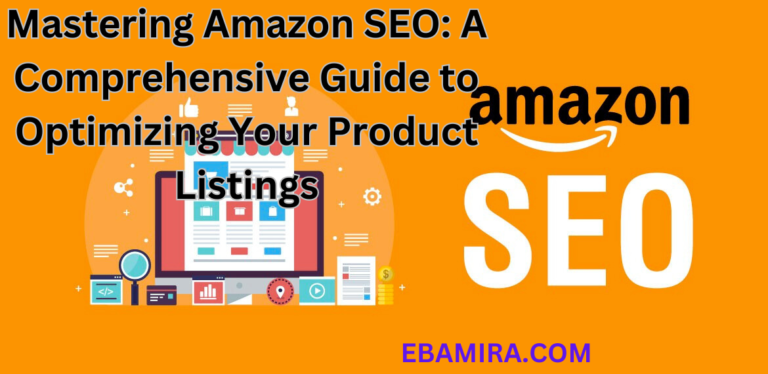The Ultimate Guide to Selling on Amazon as a New Seller
Introduction: With the exponential growth of e-commerce in recent years, Amazon has emerged as a powerhouse platform for both seasoned entrepreneurs and budding sellers alike. Whether you’re looking to start a side hustle or establish a full-fledged online business, tapping into Amazon’s vast marketplace can be a lucrative venture. However, diving into the world of Amazon selling can be daunting for newcomers. Fear not! This comprehensive guide is here to walk you through the essentials of selling on Amazon as a new seller, providing you with the knowledge and strategies to thrive in this competitive landscape.
Chapter 1: Getting Started with Amazon Selling
- Understanding the Basics of Amazon Marketplace
- Setting Up Your Amazon Seller Account
- Navigating Seller Central: A Step-by-Step Guide
- Choosing the Right Selling Plan for Your Business
- Grasping Amazon’s Fee Structure and Payment Process
Chapter 2: Identifying Profitable Product Opportunities
- Conducting Market Research: Tools and Techniques
- Analyzing Product Demand and Competition
- Selecting the Right Product Niche for Success
- Avoiding Restricted and Prohibited Products
- Leveraging Trends and Seasonality to Maximize Sales Potential
Chapter 3: Sourcing and Procuring Products
- Exploring Different Sourcing Methods: Wholesale, Private Label, Arbitrage, and Dropshipping
- Finding Reliable Suppliers and Manufacturers
- Negotiating Pricing and Terms for Bulk Orders
- Ensuring Product Quality and Compliance with Amazon’s Standards
- Managing Inventory and Supply Chain Logistics
Chapter 4: Optimizing Product Listings for Maximum Visibility
- Crafting Compelling Product Titles, Descriptions, and Bullet Points
- Enhancing Product Images: Best Practices and Guidelines
- Utilizing Keywords Strategically for SEO Optimization
- Understanding Amazon’s A9 Algorithm and Ranking Factors
- A/B Testing and Iterating Listing Elements for Improved Performance
Chapter 5: Implementing Effective Marketing Strategies
- Leveraging Amazon PPC Advertising: Campaign Setup and Optimization
- Harnessing the Power of Amazon Coupons, Deals, and Promotions
- Building a Brand Presence with Enhanced Brand Content and A+ Content
- Harnessing the Potential of External Traffic: Social Media, Influencer Marketing, and Email Campaigns
- Soliciting and Managing Customer Reviews: Strategies for Positive Feedback
Chapter 6: Managing Operations and Customer Service
- Fulfillment Options: FBA (Fulfillment by Amazon) vs. FBM (Fulfillment by Merchant)
- Streamlining Order Processing and Shipping Procedures
- Handling Returns, Refunds, and Customer Inquiries Effectively
- Maintaining Seller Performance Metrics: Order Defect Rate, Late Shipment Rate, and Customer Feedback
- Scaling Your Business: Delegating Tasks and Outsourcing Operations
Chapter 7: Monitoring Performance and Iterating Strategies
- Analyzing Sales Data and Performance Metrics: Sales Velocity, Conversion Rates, and Profit Margins
- Identifying Areas for Improvement and Optimization
- Staying Updated on Amazon Policies, Trends, and Best Practices
- Experimenting with New Products, Markets, and Strategies
- Continuously Learning and Adapting to Evolving Market Dynamics
Chapter 8: Legal and Compliance Considerations
- Understanding Tax Obligations: Sales Tax, Income Tax, and Value Added Tax (VAT)
- Complying with Amazon’s Policies and Guidelines: Terms of Service, Prohibited Practices, and Restricted Products
- Protecting Intellectual Property: Trademarks, Copyrights, and Brand Registry
- Obtaining Necessary Licenses and Permits for Your Business Operations
- Consulting with Legal Professionals for Guidance on Compliance Matters
Chapter 9: Building Brand Loyalty and Long-Term Success
- Fostering Trust and Credibility: Providing Exceptional Customer Service and Support
- Establishing a Unique Brand Identity: Logo Design, Packaging, and Brand Messaging
- Cultivating a Community of Loyal Customers: Engaging with Buyers through Social Media and Email Marketing
- Expanding Your Product Line and Diversifying Your Offerings
- Investing in Continuous Improvement: Soliciting Feedback and Implementing Iterative Enhancements
Chapter 10: Staying Ahead of the Competition
- Monitoring Competitor Activity: Pricing Strategies, Product Offerings, and Marketing Tactics
- Conducting Regular SWOT Analysis: Identifying Strengths, Weaknesses, Opportunities, and Threats
- Innovating and Differentiating Your Products: Adding Value through Innovation, Customization, or Bundling
- Keeping Abreast of Industry Trends and Emerging Technologies
- Networking with Fellow Sellers and Industry Experts: Learning from Peers and Sharing Insights
Chapter 11: Expanding to International Markets
- Evaluating Opportunities in Global Marketplaces: Amazon US, EU, Japan, and Beyond
- Overcoming Language and Cultural Barriers: Localization Strategies for Product Listings and Marketing Content
- Navigating International Shipping and Customs Regulations
- Adapting Your Business Model to Local Market Dynamics and Preferences
- Leveraging Amazon’s Global Selling Program and Fulfillment Options
Chapter 12: Planning for Long-Term Sustainability and Exit Strategies
- Setting Clear Business Goals and Milestones: Short-Term Objectives and Long-Term Vision
- Building a Solid Financial Foundation: Budgeting, Cash Flow Management, and Profit Reinvestment
- Diversifying Revenue Streams: Exploring Wholesale, Retail, and Direct-to-Consumer Channels
- Preparing for Exit: Valuing Your Business, Identifying Potential Buyers, and Transitioning Ownership
- Reflecting on Your Journey: Celebrating Achievements and Learning from Setbacks
Chapter 13: Adapting to Changes in the Amazon Ecosystem
- Understanding Amazon’s Updates and Policy Changes: Staying Informed and Flexible
- Adjusting Your Strategies in Response to Algorithm Updates and Marketplace Shifts
- Embracing Innovation: Exploring New Tools, Technologies, and Trends
- Seeking Opportunities in Market Disruptions and Economic Shifts
- Cultivating Resilience: Building a Business Model That Can Withstand Challenges and Uncertainties
Chapter 14: Investing in Education and Skill Development
- Committing to Lifelong Learning: Reading Books, Attending Webinars, and Participating in Workshops
- Expanding Your Knowledge Base: Studying Sales, Marketing, Finance, and Entrepreneurship
- Developing Transferable Skills: Communication, Negotiation, Problem-Solving, and Time Management
- Seeking Mentorship and Coaching: Learning from Experienced Professionals and Industry Leaders
- Encouraging a Culture of Learning Within Your Organization: Investing in Employee Development and Training
Chapter 15: Embracing Sustainability and Social Responsibility
- Incorporating Environmental Sustainability into Your Business Practices: Reducing Waste, Conserving Resources, and Minimizing Carbon Footprint
- Supporting Ethical Sourcing and Fair Labor Practices: Partnering with Suppliers and Manufacturers Who Prioritize Social Responsibility
- Giving Back to Communities: Donating a Portion of Profits to Charitable Causes or Engaging in Volunteer Work
- Building a Brand with Purpose: Communicating Your Commitment to Sustainability and Social Impact to Customers
- Inspiring Positive Change: Encouraging Other Businesses to Follow Suit and Adopt Sustainable Practices
Chapter 16: Overcoming Challenges and Adversities
- Recognizing Common Challenges Faced by Amazon Sellers: Competition, Pricing Pressure, and Supply Chain Disruptions
- Developing Strategies for Resilience and Adaptability: Building Contingency Plans and Diversifying Risk
- Seeking Support from Fellow Sellers and Industry Networks: Sharing Experiences and Strategies for Overcoming Challenges
- Maintaining a Positive Mindset: Viewing Challenges as Opportunities for Growth and Innovation
- Celebrating Successes and Milestones: Recognizing Your Achievements and Progress Along the Journey
Conclusion: As you continue your journey as an Amazon seller, remember that success is not defined solely by financial gains, but also by the positive impact you make on customers, communities, and the world at large. By embracing sustainability, social responsibility, and continuous learning, you’ll not only build a thriving business but also leave a lasting legacy. So, stay true to your values, stay resilient in the face of challenges, and keep striving for excellence. The possibilities are endless, and the future is bright for those who dare to dream and take action. Best of luck on your continued adventure in the world of Amazon selling!





